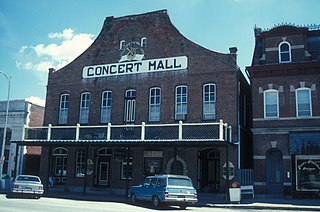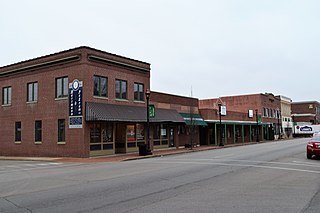
Downtown Columbia is the central business, government, and social core of Columbia, Missouri and the Columbia Metropolitan Area. Three colleges — the University of Missouri, Stephens College, and Columbia College — all border the area. Downtown Columbia is an area of approximately one square mile surrounded by the University of Missouri on the south, Stephens College to the east, and Columbia College on the north. The area serves as Columbia's financial and business district and is the topic of a large initiative to draw tourism, which includes plans to capitalize on the area's historic architecture and Bohemian characteristics. The downtown skyline is relatively low and is dominated by the 10-story Tiger Hotel, built in 1928, and the 15-story Paquin Tower.

The Walnut Street Historic District is a national historic district located in Springfield, Missouri, United States. The district encompasses more than 150 one and two story frame, brick, cast-stone, or stone dwellings in a thirteen block area. The district includes parts of East Walnut Street, East Elm Street, East McDaniel Street, Cordova Court, South Hampton Avenue, South Florence Avenue, and South National Avenue. The district developed between about 1870 and 1940, with 21 buildings surviving from before 1900, and 59 buildings dating between 1901 and 1910.

Hermann Historic District is a national historic district located at Hermann, Gasconade County, Missouri. The district encompasses 360 contributing buildings, 4 contributing structures, and 3 contributing objects in the central business district and surrounding residential sections of Hermann. The district developed between about 1838 and 1910, and includes representative examples of Greek Revival and Classical Revival style architecture. Notable buildings include the Eitzen House (1855), Potnmer-Gentner House (1848), Hermann City Hall (1906), Strehly House (1845), Concert Hall (1877), The German School (1871), and Gasconade County Courthouse (1896).

Cape Girardeau Commercial Historic District is a national historic district located at Cape Girardeau, Missouri. In 2000, the area listed was 1.6 acres (0.65 ha) and included 17 contributing buildings. In a first increase, an 1891 contributing building at 101 North Main Street was added. The building was designed by Jerome B. Legg and Henry Ossenkop in Romanesque style. In a second increase, three contributing buildings dating from 1870 were added. The two increases added .9 acres (0.36 ha) each to the original listed area.

The East Columbia Historic District is a national historic district located at Farmington, St. Francois County, Missouri. The district encompasses 11 contributing buildings in the central business district of Farmington. It developed between about 1879 and 1954, and includes representative examples of Late Victorian, Beaux Arts, and Bungalow / American Craftsman style architecture. Notable buildings include the Tetley Jewelry Store, Andy Hahn Building, Lang and Holler Building, U.S. Post Office, and Henry C. Meyer Building, and T.F. Lockridge Harness Co. Building / Wichman Nash Service.

The St. Charles Historic District is a national historic district located at St. Charles, St. Charles County, Missouri. It is the site of the first permanent European settlement on the Missouri River and of the embarkation of Lewis and Clark's journey of exploration along the Missouri. The first state capital of Missouri and over one hundred other historic buildings are located in the district.

Walnut Street Commercial Historic District is a national historic district located at Springfield, Greene County, Missouri. The district encompasses seven contributing buildings in a commercial section of Springfield. The district developed between about 1895 and 1949, and includes representative examples of Italianate and Colonial Revival style architecture. Located in the district is the separately listed Landers Theater. Other notable buildings include the Masonic Temple (1906).

South Avenue Commercial Historic District is a national historic district located in Springfield, Missouri, United States. The district encompasses 10 contributing buildings in a commercial section of Springfield. The district developed between about 1895 and 1949, and it includes representative examples of Italianate and Colonial Revival style architecture. Notable buildings include the Medical Arts Building (1929) and Springfield Life Building/Savoy Hotel/Hotel Seville.

Springfield Warehouse and Industrial Historic District is a national historic district located at Springfield, Greene County, Missouri. The district encompasses 16 contributing buildings and 1 contributing structure in a commercial / industrial section of Springfield. The district developed between about 1891 and 1948, and includes representative examples of Italianate and Romanesque Revival style architecture. Notable buildings include the Springfield Ice and Refrigerator Company, Armour Creamery Boiler House, Andrew Rebori Company, Crighton Provision Company, and Armour Creamery Cold Storage Warehouse.

Mid-Town Historic District is a national historic district located in Springfield, Missouri, United States. The district encompasses 455 contributing buildings, 8 contributing structures, and 7 contributing objects in a predominantly residential section of Springfield. The district developed between about 1871 and 1952, and includes representative examples of Late Victorian, Colonial Revival, and Bungalow / American Craftsman style architecture. Located in the district are the separately listed Bentley House and Stone Chapel. Other notable buildings include buildings on the Drury College campus, Central Christian Church (1926), St. Johns Episcopal Church (1886), Mary S. Boyd School (1911), and Trinity Lutheran Church.

Springfield Public Square Historic District is a national historic district located at Springfield, Missouri, United States. The district encompasses 27 contributing buildings, 1 contributing site, 1 contributing structure, and 2 contributing objects in Springfield's central business district. The district developed between about 1890 and 1959, and includes representative examples of commercial architecture. Located in the district are the separately listed Franklin Springfield Motor Co. Building, Gillioz Theatre, Heer's Department Store, Netter-Ullman Building, and Marx-Hurlburt Building. Other notable resources include the Landers Building (1915), F. W. Woolworth Co. (1954), J. J. Newberry Co. (1951), S. S. Kresge Co. (1953), Springfield Cigar Company, Stancill Drug Store, National Shirt Co, Salvation Army, Public Square, Queen City Bank (1914), Frisco Office Building (1910), and Cantrell Building.

Heer's Department Store, also known as the Greater Heer Store, is a historic Heer's department store building located at Springfield, Greene County, Missouri. It was built in 1915, and is a seven-story commercial building which is sheathed with cream colored terra cotta. A two-story addition was constructed in 1951. The building was remodeled in 1967. The store closed in 1995.

Netter–Ullman Building, also known as "Netter's temporary home of the Heer store", is a historic department store building located at Springfield, Greene County, Missouri, United States. It was built in 1913, and is a three-story, rectangular red brick commercial building. It measures 107 feet wide by 127 feet deep. It features understated limestone insets and horizontal limestone belting.

Marx–Hurlburt Building are two historic commercial buildings located at Springfield, Greene County, Missouri. They were built about 1900, and are two- and three-story, rectangular Classical Revival style commercial buildings.

Hotel Sansone, also known as the Hotel Springfield and Hotel Sterling, is a historic hotel building located in Springfield, Missouri, United States. Built in 1911, it is a four-story American Craftsman style brick building. It measures 44 feet wide by 110 feet deep. It features a stepped parapet, beneath which is set a shallow overhanging hip roof sheathed with green Spanish tiles, and supported by heavy carved wooden brackets.

Edina Double Square Historic District is a national historic district located at Edina, Knox County, Missouri. The district encompasses 37 contributing buildings in the central business district of Edina. It developed between about 1865 and 1945 and includes representative examples of Italianate and Streamline Moderne style architecture. Notable contributing buildings include the Public Works Administration funded Knox County Courthouse (1934–1935) designed by William B. Ittner, Bishoff Bakery (1891), Northern Hotel (1860s), Ennis House/Northern Hotel, Edina School and Gymnasium (1915–1916), D. H. Mudd Building, Phillip Linville Building, Tobias J. Lycan Building, Jacob Pugh Building, Albert G. Bostick Building, Knox County Savings Bank, Thomas Burk Buildings, Bank of Edina Building, Joseph F. Biggerstaff Buildings, Stablein Building, and Knox County Public Library.

Union Electric Administration Building-Lakeside, also known as Willmore Lodge and Egan Lodge, is a historic administration building and retreat overlooking Lake of the Ozarks and located near Lakeside, Miller County, Missouri. It was built in 1930 by Union Electric Company during the Bagnell Dam project. It is a one- to two-story, "V"-shaped Adirondack rustic style log building. It has a stone veneer foundation and an intersecting gable, cedar shake roof.

Neosho Commercial Historic District is a national historic district located at Neosho, Newton County, Missouri. The district encompasses 38 contributing buildings in the central business district of Neosho. It developed between about 1868 and 1943, and includes representative examples of Victorian and Modern Movement architecture. Notable buildings include the Newton County Courthouse (1936), Newton County Jail (1888), Haas Building (1906), First National Bank (1922), Auditorium and City Hall (1938), Masonic Lodge, and Newton County Bank (1884).

The Osage Farms Resettlement Properties in Pettis County, Missouri is a National Register of Historic Places multiple property submission located at Pettis County, Missouri. The submission includes 10 national historic districts and 2 individual properties listed on the National Register of Historic Places. The properties included were built by the Resettlement Administration / Farm Security Administration in 1937 as model farms and known as Osage Farms. Model farmsteads typically included a 1 1/2-story frame dwelling, barn, poultry house and privy.

The Sedalia Commercial Historic District is a national historic district located at Sedalia, Pettis County, Missouri. It encompasses 102 contributing buildings in the central business district of Sedalia. The district developed between about 1870 and 1959, and includes representative examples of Italianate, Romanesque Revival, and Art Deco architecture. Located in the district are the separately listed Hotel Bothwell, Building at 217 West Main Street, and Missouri/Sedalia Trust Company. Other notable buildings include the First United Methodist Church (1888-1891), Pettis County Courthouse (1924), Anheuser Busch Bottling Works, the New Lona Theater (1920), Citizens National Bank Building, Third National Bank (1929), Federal Building (1930), Montgomery Ward Building (1936), the Uptown Theatre (1936), Missouri Pacific Depot, and Central Presbyterian Church.


















